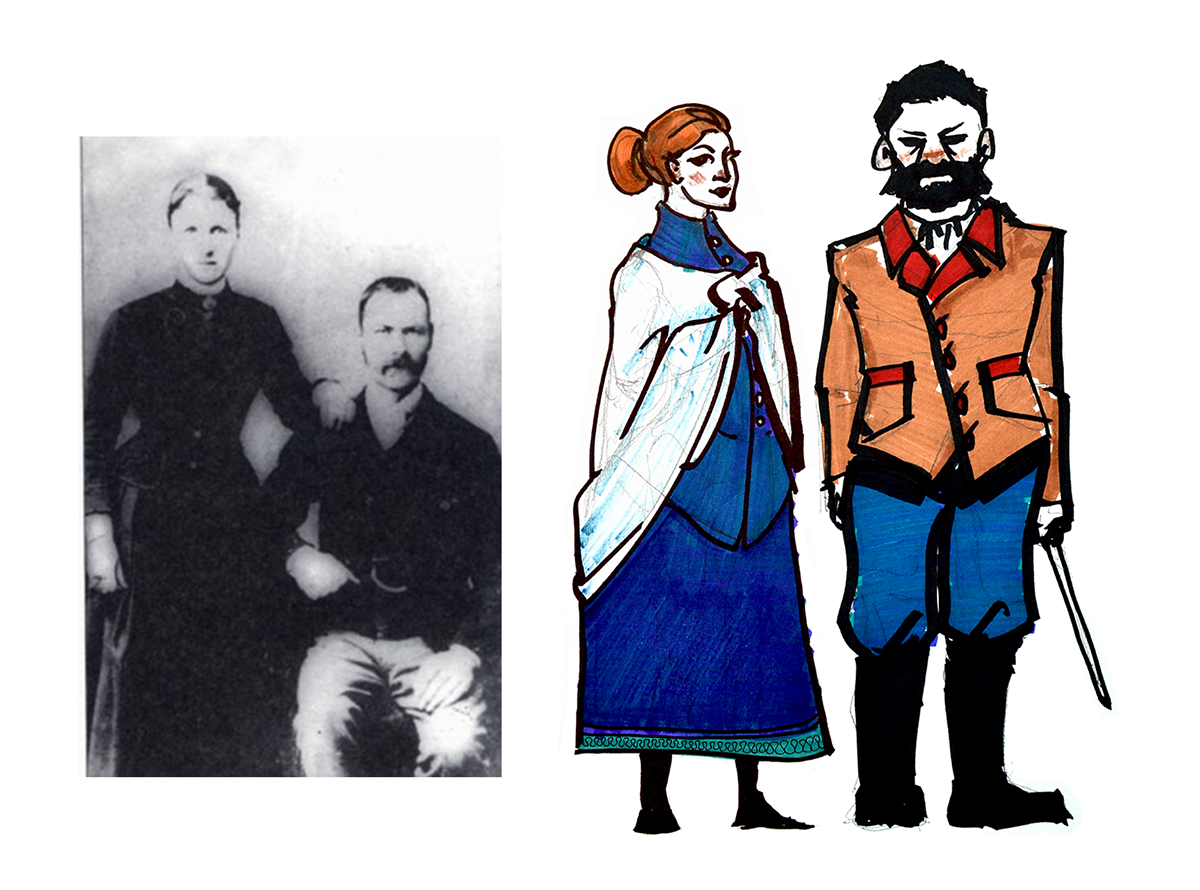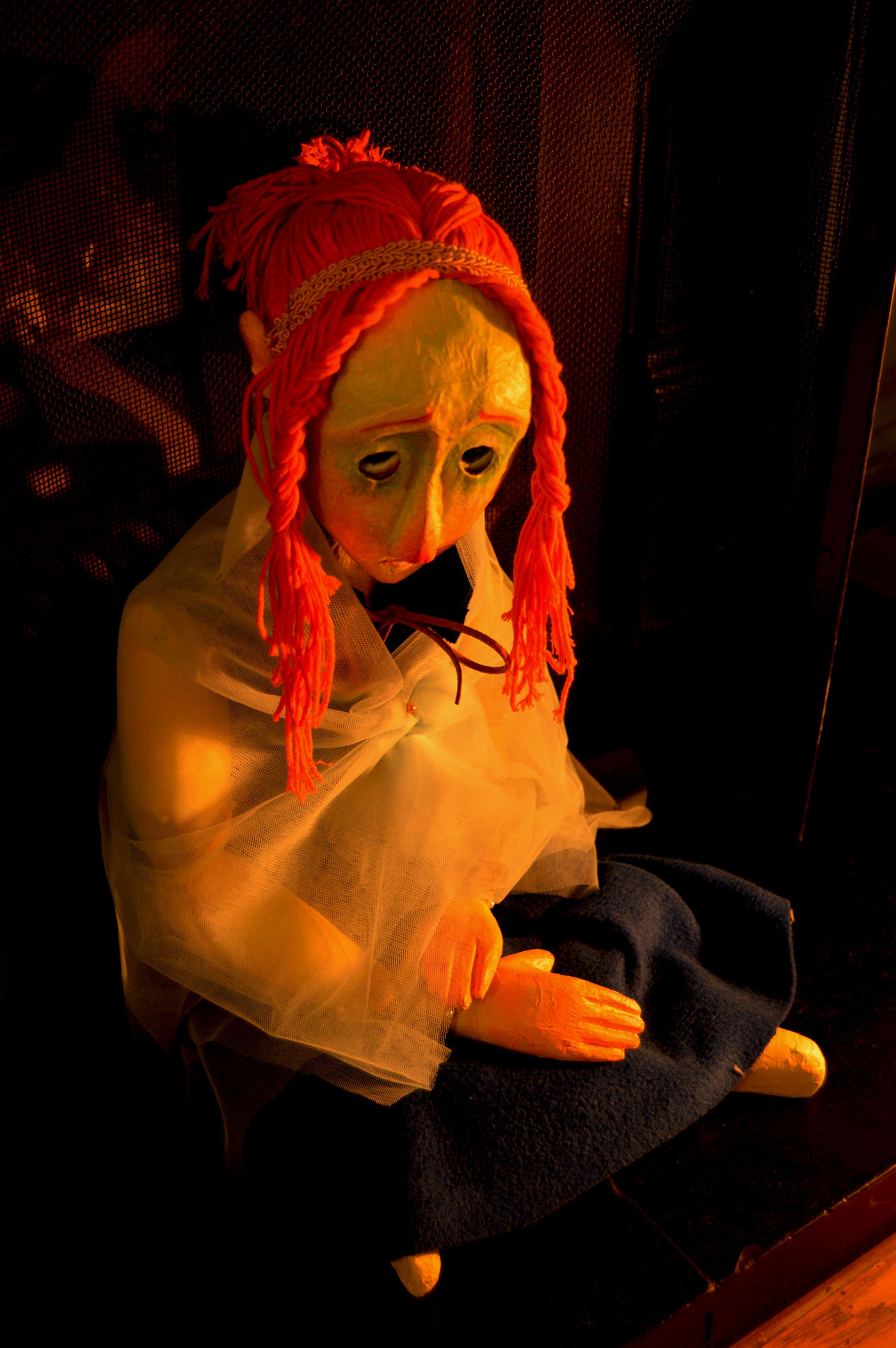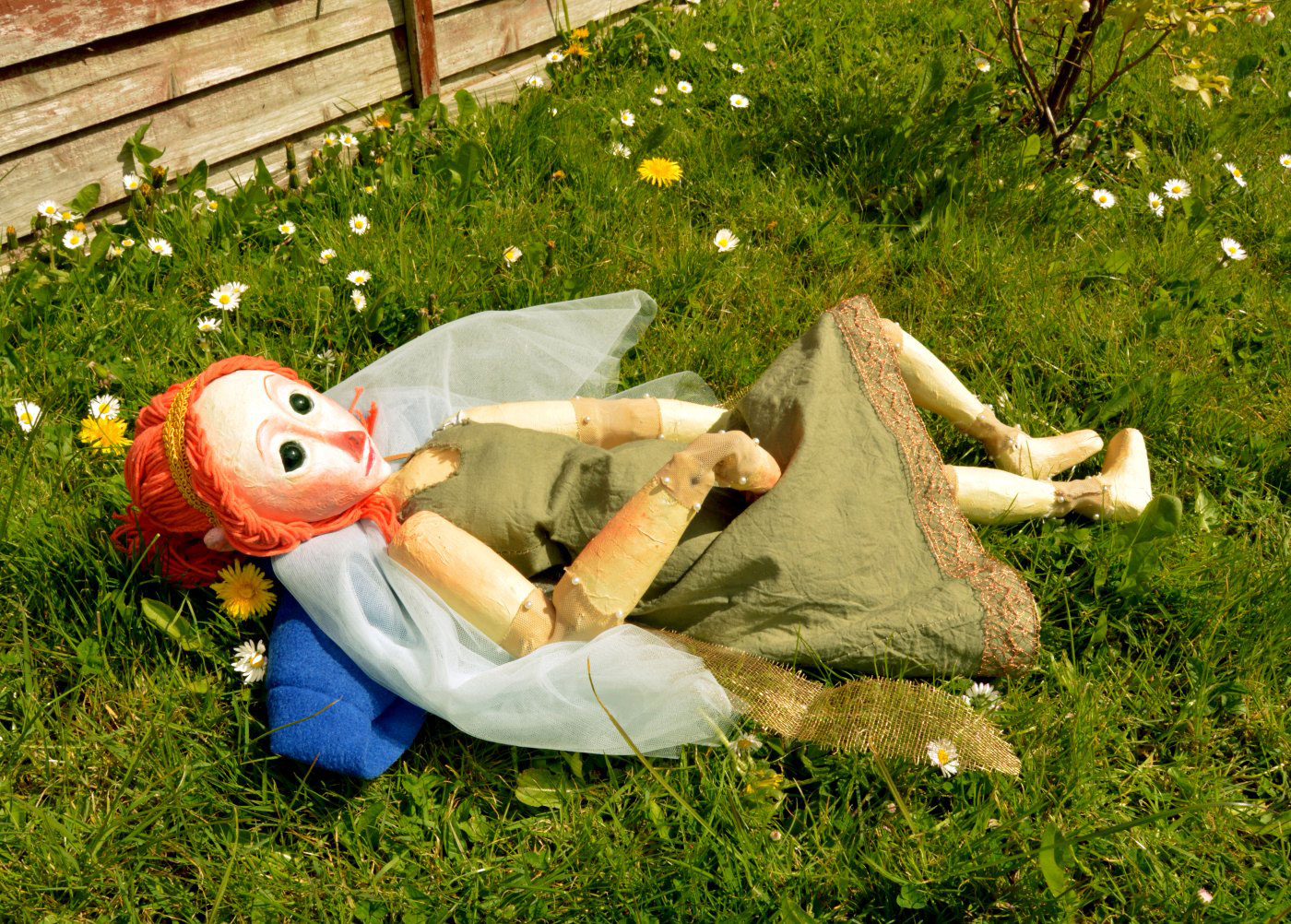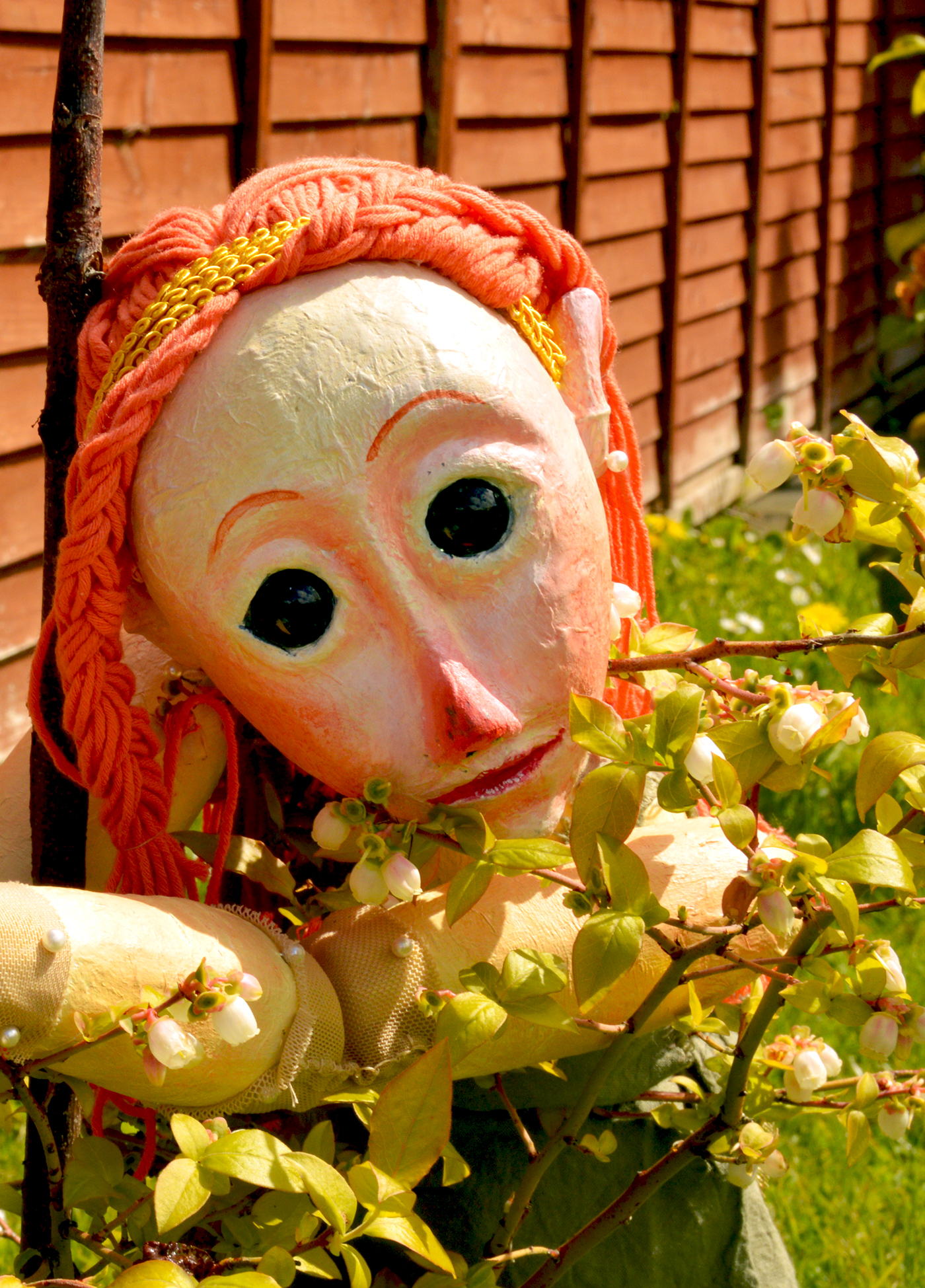
This project is the result of the Street Theatre Module, the last assignment for the 2nd year in Model Making, Design and Digital Effects at IADT Dún Laoghaire, Ireland. The project objective is to develop a puppet or costume for street theatre, based on a piece of narrative. The theme for the module was Forest Dwellers and Fairies, and I couldn't be more delighted. My first idea was a bit obvious: Titania, Oberon or Puck from Shakespeare's A Midsummer Night's Dream. After watching the play two times by two different companies while in Ireland, one of the characters, however, was always intriguing me: the Indian boy – the changeling.
My first contact with the changeling myth was through the RPG Changeling: the Dreaming, back in 2006; and its successor, Changeling: the Lost was the definite proof that this is one of my favourite legends among fairy stories. So, I decided to use the changeling as my character, and even before I searched through the books again, I remembered a name, which was cited in The Lost: Bridget Cleary.
Before I say anything about Bridgit, however, it's important to explain the myth: in Europe, specially in the British Isles and Ireland, the belief in fairies and magical creatures was very strong, with their tales used to understand the world. The changeling was (according to some folklorists) the way people had to explain diseases, malformation and other oddities related to childbirth and misbehavior. People believed that fairies kidnapped children, and sometimes adults, and left another fairy behind, a copy of the stolen human. This "clone" was the changeling.
Being a fairy, and not really a human, explained people with mental diseases, children that didn't grew up, infantile paralysis, misbehaviour in adults and so on. They were fae, they didn't know how to be a real person.
Bridget Cleary, a 26-years-old Irish woman, was killed by her husband, Michael Cleary, on the night of the 15th of March of 1895. Two weeks before, she fell ill, and several things led her husband to believe that the woman who was sick in bed was not his wife, but a changeling. Superstition convinced her father, her cousins and neighbours, and they believed in Michael. The fact that she couldn't eat the Holy Communion, or repeat her own name three times, or eat three bits of bread, among other ordeals, led everyone to assume that Bridget was, in fact, a fairy. On her last three days alive, she was beaten, thrown in the ground, threatened with fire and even strangled (and that left her throat so sore that she couldn't eat anything nor speak properly).
She was burned and buried in a shallow grave, hidden, while her husband waited for three days in a hill nearby, where he believed that the "true" Bridget would appear. Michael and several people were accused of manslaughter in what was called The Last Witchcraft Trial of Ireland.
My version of the story has a happy ending: when Bridget is burned, she turns into a fairy. The fire actually saves her from pain, and she flees to the fairy realm.

Left: Bridget and Michael Cleary probably around 1887, time of their wedding. Right: my first designs for both of them.
Esquerda: Bridget e Michael Cleary provavelmente por volta de 1887, quando se casaram. Direita: meu primeiro design pros dois.
O Suplício de Bridget Cleary: um design baseado em narrativa
Esse projeto é resultado do módulo de Teatro de Rua, o último trabalho do segundo ano do curso de Model Making, Design and Digital Effects no IADT Dún Laoghaire, Irlanda. O objetivo do projeto é desenvolver um fantoche ou figurino para teatro de rua, baseado em uma narrative. O tema do módulo foi Fadas e Habitantes da Floresta, e eu não podia ficar mais feliz com isso. Minha primeira ideia era meio óbvia: Titânia, Oberon ou Puck, de Sonho de Uma Noite de Verão, de Shakespeare. Depois de assistir à peça duas vezes, interpretada por duas companhias de teatro diferentes na Irlanda, um dos personagens, no entanto, continuava me intrigando: o Menino Indiano – o changeling.
Meu primeiro contato com o mito do changeling foi através do RPG Changeling: O Sonhar, em 2006; e o seu sucessor, Changeling: Os Perdidos, foi a prova definitive de que essa é uma das minhas lendas favoritas entre histórias de fadas. Então, eu decidi usar o changeling como meu personagem, e antes mesmo de olhar os livros de novo, eu lembrei de um nome, que havia sido citado em Os Perdidos: Bridget Cleary.
Antes de eu falar qualquer coisa sobre Bridget, no entanto, é importante explicar a lenda: na Europa, especialmente nas Ilhas Britânicas e na Irlanda, a crença em fadas e criaturas fantásticas era bem forte, e suas histórias eram meios de entender o mundo. O changeling era (de acordo com alguns folcloristas) o jeito que as pessoas tinham de explicar doenças, malformação e outros males relacionados ao nascimento e ao comportamento. Acreditava-se que as fadas raptavam crianças, e algumas vezes adultos, e deixavam outra fada no lugar, uma cópia da pessoa sequestrada. Esse “clone” era o changeling (em português, changeling poderia ser mal traduzido como “permutado”).
Sendo fadas, e não humanos, explicava-se o porquê de pessoas terem doenças mentais, crianças que náo cresciam, paralisia infantil, comportamento estranho em adultos, e assim por diante. Eles eram de outro mundo, não sabiam como ser uma pessoa de verdade.
Bridget Cleary, uma irlandesa de 26 anos, foi morta pelo marido, Michael Cleary, na noite de 15 de marco de 1895. Duas semanas antes, ela ficou doente, e muitas coisas levaram o marido dela a acreditar que a mulher que estava de cama não era sua esposa, e sim um changeling. Superstição convenceu o pai dela, os primos e vizinhos, e eles acreditaram em Michael. O fato dela não conseguir engolir uma hóstia, repetir o próprio nome três vezes, ou comer três pedaços de pão, além de outras provações, levou todos a presumir que aquela Bridget era, de fato, uma fada. Em seus últimos três dias de vida, ela foi surrada, arremessada no chão, ameaçada com fogo e enforcada (o que deixou a garganta dela tão machucada que ela não conseguia comer nada ou falar direito).
Ela foi queimada viva e enterrada em uma cova rasa, escondida, enquanto seu marido esperou por três dias em uma colina ali perto, onde ele acreditava que a “verdadeira” Bridget apareceria. Michael e várias outras pessoas foram acusadas de homicídio sem a intenção de matar (tamanha era a força da superstição), no que foi chamado de A Última Caça às Bruxas da Irlanda.”
Minha versão da história tem um final feliz: quando Bridget é queimada, ela se transforma em uma fada. O fogo na verdade a salva do sofrimento, e ela foge para o reino feérico.

Basic shapes drawn on paper, transfered to a blue foam block and then sculpted with a hot wire cutter. Details were then made with scalpes and sanded to smooth the piece.
Formas básicas feitas em papel, transferidas para poliestireno e esculpidos com um cortador de arame quente. Detalhes foram feitos com estiletes e lixados para suavizar a superfície.
I used a very different method of construction for this project: I didn't make plans. At least, not specific designs and blueprints that I'd follow until the end, which is usually what I do. Insted, I let the narrative and the materials themselves dictate to me what I could do. I only did some sketches and rought guides of what I needed to do, and that was it. The rest of the project was entirely directed by... Bridget herself. I did it this way to see if I could work with a different mindset. It was very hard, and I think it took longer than the usual, but I'm very satisfied with the results.
Eu usei um método de construção diferente pra esse projeto: não fiz planos. Não designs específicos, pelo menos, que eu fosse seguir até o fim, o que eu geralmente faço. Em vez disso, eu deixei a narrativa e os materiais me guiarem pra eu ver o que poderia fazer. Fiz apenas alguns sketches e guias gerais do que eu precisava ter, e foi isso. O resto do projeto foi dirigido... pela própria Bridget. Eu fiz isso pra ver se eu podia trabalhar pensando de outra maneira. Foi bem difícil, e acho que demorou mais que o normal, mas estou satisfeito com os resultados.

Due the fragility of the blue foam, I did three layers of papier-mâché. The mask was moulded on the actual face, and the eyes are green marbles.
Devido à fragilidade do poliestireno, fiz três camadas de papel machê. A máscara foi moldada diretamente no rosto, e os olhos são bolinhas-de-gude verdes.
The initial idea was making a marionette. I even made the articulations thinking about that. However, as I developed it further, and manipulated the puppet, I realized that she would work better as a bunraku - the kind of puppet animated by two or three people wearing black clothes on a dark background. Actually, that was a suggestion from my lecturer, Ger Clancy, at the beginning, but I wasn't sure at the time. As I payed more attention to the story, and to the puppet itself, I saw that a bunraku would express the kind of emotions that I wanted in a better way. That and the fact that I wanted it to change its face and clothes, which would be almost impossible with a marionette.
A ideia inicial era fazer uma marionete. Eu até fiz as articulações pensando nisso. No entanto, conforme eu desenvolvia e manipulava a boneca, percebi que ela funcionaria melhor como um bunraku - o tipo de fantoche animado por duas ou três pessoas usando roupas pretas num fundo escuro. Na verdade, isso tinha sido uma sugestão do meu professor, Ger Clancy, bem no começo, mas eu não tinha certeza daquilo. Prestando mais atenção na história, e na própria boneca, eu vi que um bunraku iria expressar melhor o tipo de emoções que eu queria passar. Isso e o fato de que eu queria que ela mudasse o rosto e as roupas, o que seria quase impossível com uma marionete.

Despite being son of a seamstress, I never tried to do anything like this before. I sewed the clothes by hand and they work pretty well, actually. I had a problem with the hair, though: I couldn't attach the yarn to the head, so I took the same fabric I've used for concealing the articulations, sticked and pinned it and stiched the strands directly onto it.
Apesar de ser filho de uma costureira, eu nunca tentei fazer algo do tipo antes. Costurei as roupas à mão e acabaram funcionando muito bem. Só tive um problema com o cabelo: não tinha como eu colocar ele diretamente na cabeça, então peguei um pouco do tecido que eu havia usado para disfarçar as articulações, colei e coloquei uns pinos e costurei o cabelo direto nele.
Bridget's eyes were made with green marbles with a tiny black dot on their backs. Her eyesockets were covered with tinfoil, which means that when she's seen from the side, they sparkle in green, but seen face to face they are deep black. She has a lovely and bright face as a fairy, and a really beaten, sad and sick face as a human. Her hair was braided in a complex way, and is tied in a bun while she's a mortal woman. Particularly, I never liked fairies with wings -- my ideal fairy lady is Morgana, not Tinkerbell. However, I thought that for this project the wings would help to make the fae nature really clear.
Os olhos da Bridget foram feitos com bolinhas-de-gude verdes, com um pontinho preto no fundo. O globo ocular foi coberto de papel-alumínio, o que significa que quando ela é vista de lado, os olhos brilham verdes, mas quando vista de frente, eles são completamente escuros. Ela tem um rosto feliz e saudável enquanto fada, mas uma expressão cansada, triste e doente como humana. Seu cabelo foi trançado de um jeito meio complexo, e é preso num coque enquanto ela é uma mulher mortal. Particularmente eu nunca gostei de fadas com asas -- minha fada ideal é a Morgana, não a Sininho. Porém, pra esse projeto eu achei que asas iriam ajudar a destacar a imagem feérica.


Michael's mask was actually a surprise. I never really thought about it, but as I was finishing the puppet, I realized that I had made nothing to represent Bridget's husband. At the beginning I made the decision that I would make just one puppet due to time restrictions, but I still felt that something was missing. I have no drawings, no designs, nothing: I just knew that I had to make something really scary and inhuman. I used my face as a rough base, covered in tinfoil, and from that point I just made papier-mâché, distorting my own features. I always found tiny eyes really frightening, so I kept them like that, even if I can't see where I'm going while wearing it.
A máscara de Michael foi uma surpresa, na verdade. Eu nunca pensei nela, mas conforme eu terminava o fantoche, percebi que não tinha feito nada pra representar o marido de Bridget. No começo eu tomei essa decisão, de fazer só um boneco porque não teria tempo suficiente, mas ainda sentia que alguma coisa estava faltando. Eu não tenho nenhum desenho, plano, nada: só sabia que eu tinha que fazer alguma coisa assustadora e inumana. Usei meu rosto como guia, cobri com papel-alumínio e a partir dali só cobri com papel machê, distorcendo minhas próprias características. Eu sempre achei olhos minúsculos algo assustador, então deixei eles desse jeito, mesmo que eu não consiga enxergar pra onde estou andando enquanto uso a máscara.




Actually, this puppet doesn't work exactly as a street theatre object. In the end, it works as a bunraku and a prop to storytelling, as Michael Cleary interacts with his own memories while confess his crime before a jury. Bridget sits on his lap, and he animates her as the story unfolds.
No fim das contas, essa boneca não funciona exatamente como um objeto pra teatro de rua. É mais como um bunraku e acessório para contar a história, conforme Michael Cleary interage com as próprias memórias enquanto confessa seu crime perante um júri. Bridget fica sentada em seu colo, e ele a anima enquanto a história se desenrola.




From left to right (da esquerda para a direita): Caoimhe Hannon, Dominika Haber, Michelle Murtagh,
Dawn Gibson Browne (hidden/escondida!), Aoife Byrne, Louis Oakes, me/eu & Pauric Conroy.
The video is a simple demonstration of animating and interacting with other characters.
O vídeo é uma demonstração simples de animação e interação com outros personagens.



